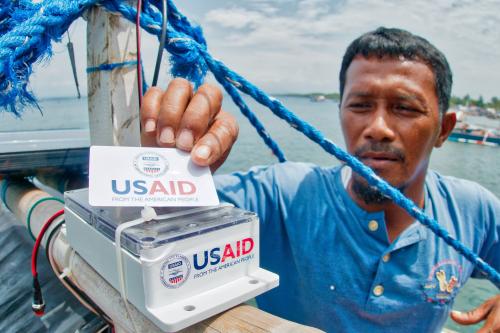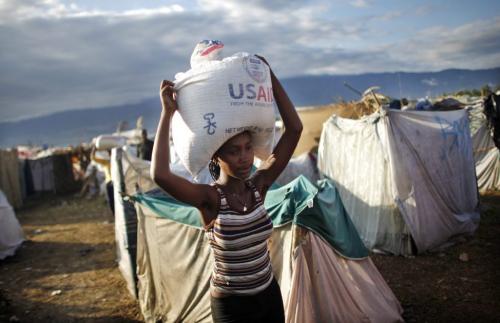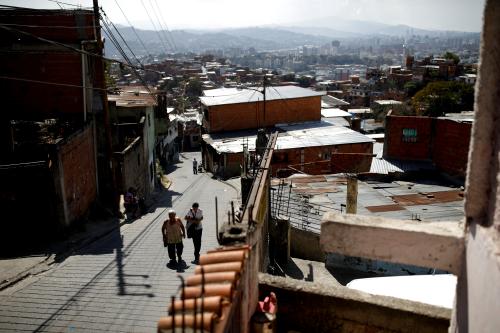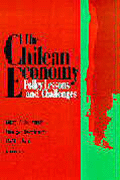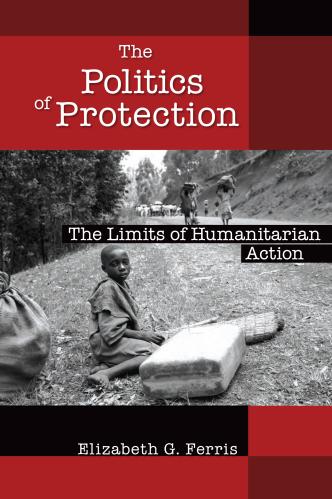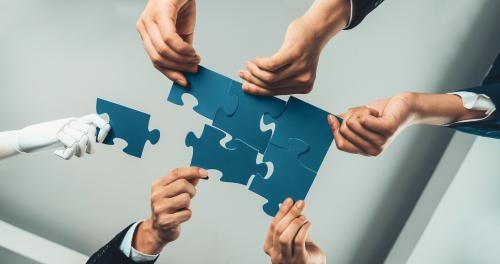Foreign assistance rarely has been a frontline issue in election campaigns, but it was barely even referenced in the 2019 presidential debates. There have been few questions asked about the subject and few requests for candidates either at the congressional or presidential levels to articulate their positions. The paucity of media attention is problematic because foreign assistance is one of the ways political leaders engage with the world and further American priorities. It raises the question of how best to engage the American people on a topic that is vital for global policy. In a 2019 dialogue, participants in the Brookings Blum Roundtable discussed this matter in some depth as part of the broader topic of how to maintain the bipartisan accord on U.S. global development. This essay builds on those threads to answer the question of how to articulate the role of foreign assistance in advancing U.S. international and domestic interests.
Three-legged stool
Ever since the Marshall Plan provided U.S. economic assistance to help rebuild Western Europe after World War II, the rationale for foreign assistance has rested on a tripartite combination of national security, human values, and economic interests. Today, those principles remain the core foundation of the U.S. foreign assistance program. On security, foreign assistance protects and projects U.S. national interests through underpinning regional and global stability and shoring up the security of allied nations. As to values, helping others in need—deploying foreign assistance in response to natural and manmade disaster to ease pain and save lives—is an innate sentiment that runs through the history of this nation and the American people. Finally, foreign assistance can help improve the economic and political dynamics that advance human welfare in a developing country and create trade and investment opportunities for American business.
How to present foreign assistance
To be relevant and comprehendible to the American people, the narrative on foreign assistance should:
- Join vision with the concrete—present a broad vision, along with specifics on how to reach it.
- Join fear with hope—threat with opportunity—draw a realistic picture of the challenge to America, along with a hopeful future.
- Bring the issue home—make the global local and personal.
- Combine altruism with self-interest.
Americans respond to a vision of a better future, but they are problem solvers who want to know how to get there. Vision is good, but will not be seized upon without a path of specific steps to achieve it.
Americans are ready for a challenge, will respond to a threat, but only if there is a hopeful outcome. The role of presenting the threat is to awaken them from complacency, but they will not take up the challenge if it is too daunting and lacks a hopeful outcome, whereupon they will vote to stay home.
It is critical to make the challenge real and personal, to bring the challenge home, in order that the American people understand how the global threat affects our daily lives. Poverty in Guatemala feels far away, but is made personal when seen as desperate mothers and children flooding across our borders to flee poverty and abuse. Poverty in Africa is made real with stories of migrants drowning as they cross the Mediterranean and disrupting the politics of friendly allies in Europe.
The humanitarian instincts of Americans are strong, and become more powerful when the response is presented as also benefiting us: improving the lives of citizens displaced by war and violence can help stabilize an important ally; stemming health epidemics elsewhere before reaching American shores and before fruit flies cross our southern border to attack American crops; assisting countries to build defenses against terrorism and cyberattacks that could provide platforms to attack America.
Examples of the narrative
The best-known foreign aid narrative is from the immediate post-World War II period with the launch of what became the modern-day U.S. foreign assistance program. The Marshall Plan was built on a real threat, a moral imperative, and U.S. self-interest. The threat was communists winning elections and seizing control in Western Europe. The moral imperative was the human suffering from a devasted post-war Europe, with millions displaced and facing starvation, ill-health, and no shelter, and our commitment to democratic institutions. The self-interest was restoring markets for U.S. goods. It was presented as a vision of a democratic, market-driven Europe standing with the U.S. to fend off communism, with concrete actions by European countries to coordinate specific steps to right their economies.
A more recent example is the President’s Emergency Plan for AIDS Relief (PEPFAR). The threat was the prospect of HIV/AIDS devastating important allies and friends and worsening the outbreak in America. The moral case was in the headlines and pictures of the sick and dying, of broken families, of children born with HIV/AIDs or parentless. The self-interest was the economic destruction from the loss and incapacitation of human life with the prospect of a healthy population contributing to a growing market for their own countries and for American trade and investment.
Where does the domestic end and the international begin?
There are two important dynamics that highlight the interrelationship of the domestic and international and that should guide future U.S. policy.
One, successful U.S. assistance programs are built on strong domestic capabilities. The Marshall Plan was built on economic efficiency driven by a unified liberal market and democratic values. HIV/AIDS was tackled first here at home before launching PEPFAR. The Green Revolution applied U.S. agriculture R&D and expertise to Asia’s farming needs. U.S. knowhow was applied to create a famine early warning system for Africa. The list goes on to democracy, education, health, and other aspects of U.S. assistance.
Two, modern communications, digital innovations, and transportation technologies have broken down borders, and the diversity of economic progress over the last forty years has made outmoded the binary concept of a first and third world. This is best represented in the Sustainable Development Goals (SDGs) which apply to all countries, unlike the predecessor Millennium Development Goals which focused only on developing countries. The extent to which the SDGs apply to all countries is reflected in the shock of recent analysis (e.g., Canada) of how far removed most advanced countries are from achieving the 2030 goals.
The answer to that age-old question is we are further apart than ever in being able to separate the domestic from the international and policy initiatives should be built on that intersection.
Vision for the upcoming Congress and president
The American people and the political system often respond better to a big idea than to incrementalism, which can seem just more of the same. Elections and the start of an administration and Congress are the time for big ideas. What could be better opportunities for a big initiative than addressing an existential challenge or opportunity: the threat to the planet of climate change; the threat of fragility to advancing development and achieving the SDGs; the glorious prospect of joining up educating the world’s children with the empowerment and employment of millions of women and youth.
Climate: The flooding of low-lying areas from New Orleans to Bangladesh to Pacific Islands, drought overtaking traditional farmland in Africa and Central America, and uncontrollable fires in Australia are only the most recent manifestations of the dangers to all countries of changing weather patterns. Populations of all stripes are demanding action. The next administration and Congress could put the U.S. into a leadership role, but not by acting alone—this is a threat to the planet that requires global cooperation. It is estimated developing nations will by 2050 be suffering $1.7 trillion of economic loss annually from climate change. The U.S. could take a lead role by dramatically increasing its modest foreign aid funding for climate change (in the range of $1 billion for FY2020), including for multilateral climate funds—Climate Investment Funds, Green Climate Fund, and Global Environmental Facility.
Building on the concept that the domestic is international, what would make this exciting for the American people is the big idea of joining the vision of the Marshall Plan and with the vision of President John F. Kennedy’s “moon shot”—the mobilization of public and private resources, at the national and local levels, to bring American ingenuity to the dual tasks of climate change prevention and adaptation, both here and abroad. Such an initiative would address the threat of climate change, appeal to American values of helping to save people and countries—in this case the planet—and put the U.S. in a position to reap economic returns from the investment in scientific and technological innovation. Fortunately, there has been strong action at the state and local levels and in the business community to reduce our impact on climate that the next administration and Congress could build upon for a strong national and foreign assistance initiative.
Fragility: Whereas climate change is the existential threat to the planet, fragility is the existential threat to development. The political, security, social, and economic breakdown in nations that are in or near a state of fragility prevents them from addressing the welfare and security needs of their citizens, thereby preventing the world from achieving the Sustainable Development Goals by 2030 and endangering regional and global stability and prosperity. The good news is the policy community is coalescing around a core set of principles of how to address fragility, the common threads of which are found in the administration’s Stabilization Assistance Review, the report of the United States Institute of Peace-sponsored Task Force on Extremism in Fragility States, and the recently enacted Global Fragility Act of 2019.
Pursuant to the fiscal year 2017 appropriations bill that funded the USIP task force, the Trump administration is just launching an initiative to deal with fragility in Burkina Faso. Based on the initial experience with that pilot, the next administration and Congress should ramp up the initiative to 4 to 6 additional countries with focused attention through a common interagency framework that has all agencies working from the same playbook, empowering the U.S. in-country field mission to manage the program so it can be rapidly adapted to changing circumstances, and with leadership from local stakeholders and collaboration with other international donors.
There will always be shocks to any system. The key to preventing and springing back from fragility is resilience. The U.S. has had the capability to bounce back from shocks, but hurricanes like Katrina and Maria, California wildfires, and Russian political hacking demonstrate our systems of prevention and resilience need to be strengthened. So, this international initiative could be accompanied by a domestic program of strengthening our resilience to anticipated shocks.
Education, women, youth: Women are half the world’s population but in many countries are second class citizens denied the opportunity to contribute to the development of their communities and countries. Youth, a quarter of the world’s population, are the hope for the future, but also a potential danger if not properly occupied. An estimated 263 million children and young people are out of school. Tests in select developing countries in 2018 revealed only 12 percent met minimum proficiency levels for math and 23 percent for reading.
Education is the path to empowering women and youth and ensuring they can contribute to their societies. SDG 4 on education and lifelong learning includes the goal of substantially increasing the supply of qualified teachers. A recent UNESCO report calculates the gap in the number of teachers between now and 2030 as 68.8 million. As many teachers leave the teaching profession after a few years, either to raise families or enter other occupations, and the quality of learning needs to be substantially raised, the U.S. should take up the challenge to lead an initiative, in collaboration with other donors and the private sector, to train this number and more by 2030, with laser focus on improving learning, empowering girls, and facilitating the transition of youth from education to employment.
Again, as advanced as we are in the United States, our students are not learning at the level they should, women are not yet treated with the equality they deserve, and too many of our youth are adrift. So, there should be a domestic counterpoint to this international initiative. That would help build public understanding and support for goals of U.S. foreign assistance.
The Brookings Institution is committed to quality, independence, and impact.
We are supported by a diverse array of funders. In line with our values and policies, each Brookings publication represents the sole views of its author(s).



